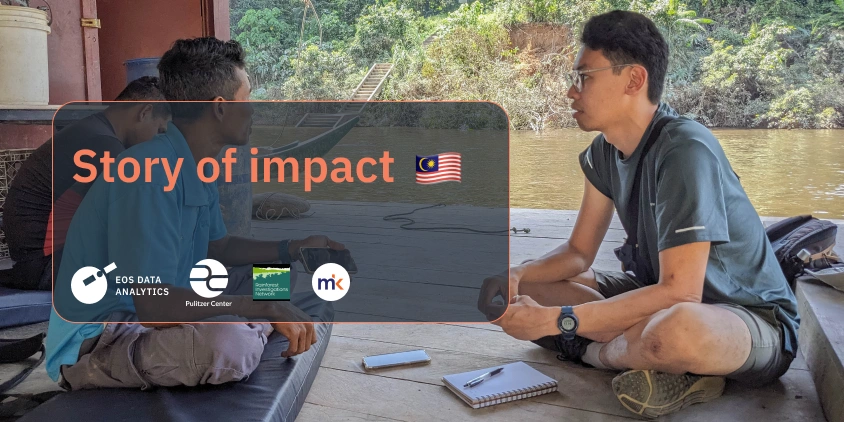
A Story Behind A Story On Pahang Oil Palm Plantations
In previous stories of impact, EOS Data Analytics has highlighted how individuals take action and utilize remote sensing tech to tackle various environmental problems. However, before any problem can be addressed, it must first be discovered and brought to public attention. In this regard, the power of the written word is crucial, often making journalistic investigations the starting point for future conservation efforts.
On March 31, 2024, Malaysian journalist Choon Chyuan Low published an investigative report titled “Timber Grab: The Truth Behind Pahang Oil Palm Supported by the Pulitzer Center and published by Malaysiakini, a major local media outlet , the report leverages satellite imagery and includes research conducted by EOS Data Analytics. It exposes how these plantations disrupt local ecosystems and communities while masking ongoing deforestation efforts. Intrigued by the scale and implications of Choon Chyuan’s work, and believing in the importance of his cause, EOS Data Analytics engaged with him once again, this time to uncover the broader story behind his impactful investigation.
The State Of Environmental Journalism In Malaysia
Since gaining independence in 1957, Malaysia was governed by the Alliance Party and later its successor, Barisan Nasional, until 2018. These parties emphasized nationalism, ethnic-based policies, conservative values, and developmentalism. Despite tensions and difficulties, Malaysia experienced a decline in poverty rates, infrastructure development, and generally robust economic growth .

However, when a single party rules for such a long period, issues such as corruption, cronyism, and uneven wealth distribution are inevitable . For a country that relies on fair trade with partners, especially capitalist countries, these issues can tarnish its reputation and lead to economic setbacks .
With freedom of expression written in the Malaysian Constitution, diverse media landscape, and support from both the international community and local civil society groups, it was a matter of time for journalists to acquire enough authority and capability to expose corruption through their investigations .
Perhaps the most prominent conspiracy that came to light and involved several nations, including Malaysia, was the 1Malaysia Development Berhad Scandal . Along with others, such as the National Feedlot Corporation Scandal and Felda Scandal , they become primary reasons for the public’s decision to change the ruling party. Elected in 2018, the Pakatan Harapan coalition promised anti-corruption reforms, greater transparency, and protection for whistleblowers .
Despite another government shift in 2020, efforts to combat corruption have continued, with investigative journalism playing a pivotal role in this process .
However, the situation is not as favorable when it comes to critical reporting on environmental issues in Malaysia, a country that is home to many endangered species and unique tropical rainforests covering 60% of the country’s land area. Backlash from authorities, national security laws, government restrictions, pressure from industry stakeholders, and limited resources often compel journalists to practice self-censorship to avoid repercussions in their environmental reporting.
But this has not been the case with Choon Chyuan Low.
Why There’s Almost No Oil Palm From Pahang Oil Plantations
On March 31, 2024, Choon Chyuan Low, a Rainforest Investigations Network Fellow at Pulitzer Center, published a story under the unassuming title “Timber Grab: The Truth Behind Pahang Oil Plantations”.
He begins his article by sharing his impressions from his visit to Kampung Tanah Pindah, a village so remote it relies solely on the surrounding nature. This dependence has become increasingly challenging since 2014, when the state development corporation, Perbadanan Kemajunan Negeri Pahang (PKNP), was authorized to convert jungles around the local river into 8,093-hectare-wide oil palm plantations.
However, when Low visited the site in July 2023, he found little evidence of plantations. Instead, sparse vegetation covered the lands, with only isolated oil palm trees, many of which had been damaged by elephants. The latter’s dung and footprints were scattered throughout the area. Low confirmed that, contrary to average expectations of yielding 35 kilograms of fresh fruit bunches per hectare per year, the plantation was only producing seven.
This irresponsible land management has had devastating consequences for the local community. The river water has become so murky that it is no longer potable, and the disappearance of fish, a vital food source, along with the increased presence of elephants, poses an escalating threat to the villagers.
As the investigation revealed, the real intent behind the plantations was never to cultivate oil palms, which would necessitate a different, more law-abiding, and environmentally sensitive approach. The primary motive was timber sales, which require less expertise and are more lucrative than oil palm fruit.
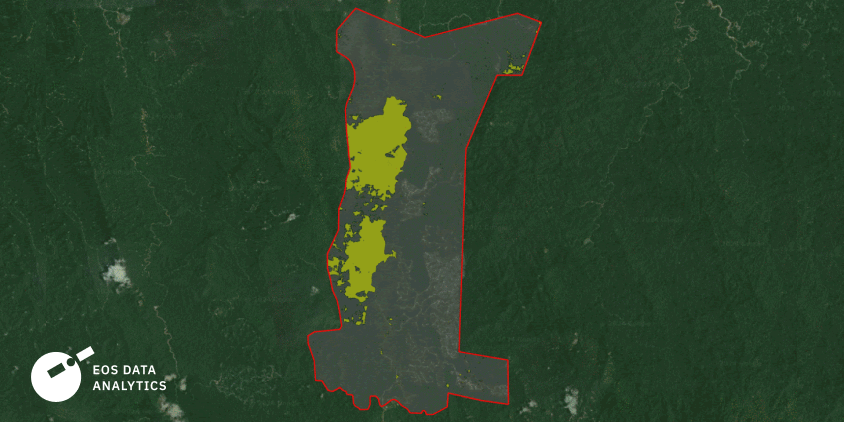
Despite governmental efforts to protect forests and prohibit such land manipulations, particularly with oil palm plantations, an additional 539 hectares of forest were cut down in the area between January 2020 and February 2024. To avoid accusations, PKNP does not conduct logging and timber sales directly but through a network of affiliated companies, some owned by relatives of the region’s sultan.
In his article, Choon Chyuan Low names these companies, detailing their connections to state officials and how VIPs evade inspections on the plantations.
While much can be done to restore nature in the region and assist the local population, Choon Chyuan Low concludes his article with the views of the CEO of the Center for Combating Corruption and Cronyism. The CEO believes that society first needs greater transparency in these processes to effectively take action and influence the authorities. Only then can feasible changes on the ground become possible.
Choon Chyuan Low’s Reporter Journey From Crime Chronicles To Conservation
The abundance of details and depth of research make it such a comprehensive read that it will take you at least half an hour to finish it for the first time. The interactive visuals complementing the material on the Malaysiakini website add a mesmerizing effect to the narrative. Still, behind this massive work is only one researcher and writer – Choon Chyuan Low, and this is his first solo investigation on an environmental issue.
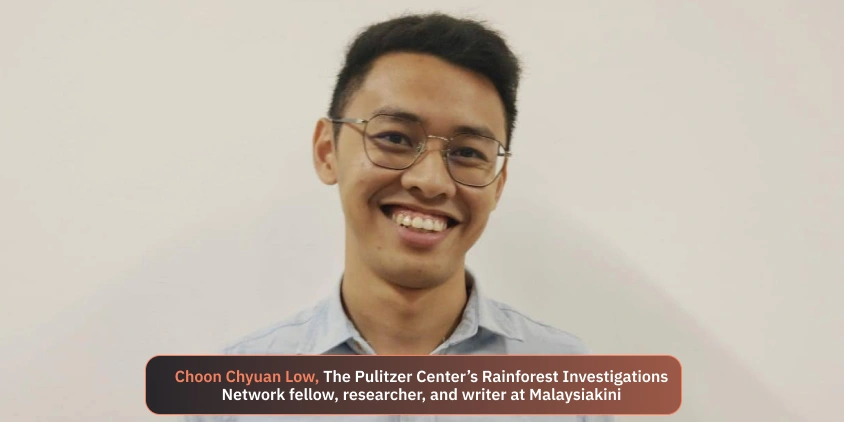
After graduating from university in Singapore, Choon began his career as a crime journalist at a local newspaper. He visited hospitals to gather crime news but soon realized there was little public interest in this area. So he returned to Malaysia to focus on feature news in Sin Chew Daily and later joined Malaysiakini, a platform known for its political coverage.
Despite lacking a background in environmental science, he was initially tasked with analyzing Environmental Impact Assessment reports, especially those involving politically connected projects and governmental or royal business interests.
The story around Pahang oil palm plantations started with a tip-off about a new tiger reserve in a state where the local prince was advocating for land protection. Upon further investigation, Choon Chyuan Low discovered a poorly managed plantation, prompting further scrutiny.
Someone had to take this on, and while I’m not trying to be a hero, it’s clear that these issues are often whispered about but seldom addressed publicly. I believe my team at Malaysiakini is among the few who dare to highlight the intricate relationships and interests underpinning these plantation and forest projects.
The start of the investigation coincided with receiving a fellowship at the Pulitzer Center’s Rainforest Investigations Network (RIN), which then supported him both financially and professionally in this venture. His editors there urged him to conduct a structured investigation in order to appeal to an international audience. Thus, the final report includes a broad examination of political and royal influences on plantation projects across Malaysia, not just the plantation practices themselves.
The project coordinator helped him enhance the technical side of the investigation by suggesting looking into satellite data about the area.
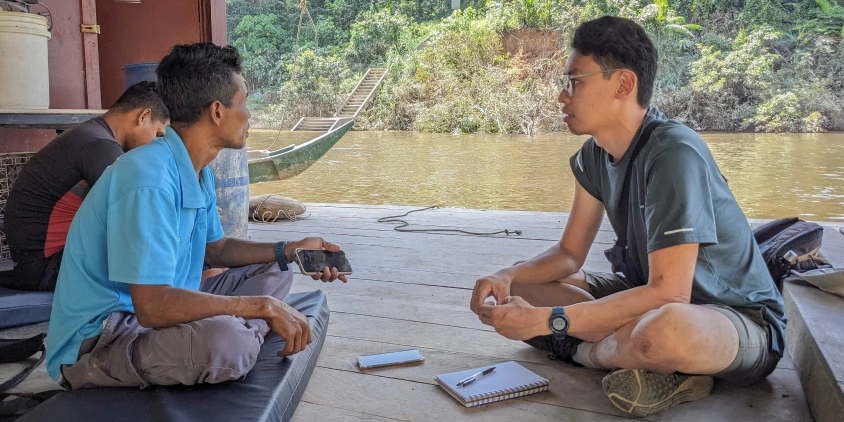
Unlike previous desk-based reporting, this investigation involved traveling, networking with stakeholders, and exploring environmental issues in-depth, without any deadlines. As a result, it took Low a year to complete the report. He developed it iteratively, through multiple drafts, to incorporate new findings and insights as the investigation unfolded.
And what a comprehensive and nuanced report it is.
EOSDA LandViewer
A vast online catalog of free satellite imagery for processing and downloading.
How EOSDA Helped Assess Environmental Damage By Measuring Deforestation And Unsequestered Carbon
Low Choon Chuyan’s investigation is rich with media. While he utilized satellite images from Planet Labs and CNES to illustrate the plantation, it was EOS Data Analytics that delivered something more valuable: the analytics derived from such images.
When we decided to estimate the carbon emissions from the plantation, I realized the complexity of the task and knew we needed unique technical expertise. With EOS Data Analytics’ insights, we managed to not only quantify the damages but also engage our readers effectively.
Typically, our stories of impact are built on insights retrieved from our readymade platforms, such as EOSDA Crop Monitoring or EOSDA LandViewer. The nature of Choon Chyuan Low’s request, however, necessitated that our science team conduct detailed research beyond merely using our tools.
Forests are globally recognized for their ability to sequester carbon, which mitigates climate change by reducing the rate at which the planet heats up. This heating process also affects air temperature and microclimate, which already happens in various regions . Therefore, understanding the negative consequences of deforestation can best be achieved by measuring the potential amount of soil organic carbon that could have been sequestered if the deforestation had not occurred.
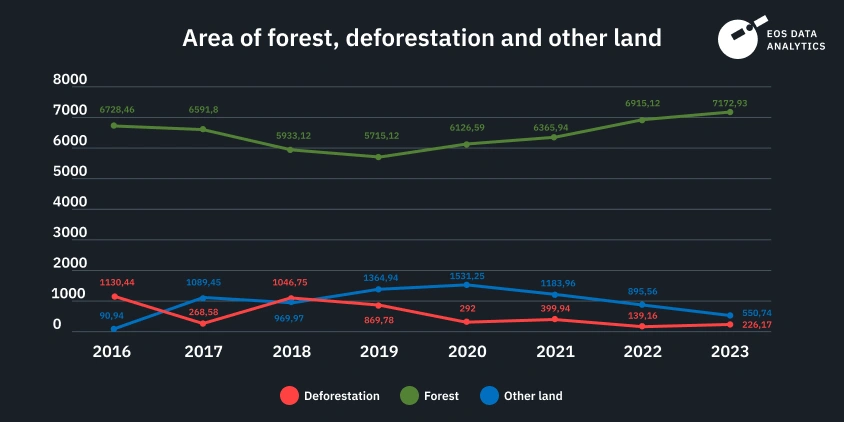
Using historical satellite images, the soil scientist Vasyl Cherlinka – along with his colleagues at EOSDA – first measured the rates of deforestation in the Pahang Area from 2016 to 2023. He then integrated this data with climate parameters to calculate the carbon sequestration rate for each year using the Ex-Ante Carbon-balance Tool. Here’s the key outcome from his study:
If the deforestation in that area had not occurred from 2016-2023, the forests that would have continued growing could have sequestered 227,395 tons of carbon dioxide during that period. Instead, this is now the amount of greenhouse gases released into the atmosphere as a result of deforestation. This can be equated to the carbon dioxide emitted by approximately 228 thousand long-haul flights performed in the same eight years.
While Malaysian authorities are still lagging in promoting carbon sequestration and implementing effective nationwide policies in this regard, they have already committed to sustainable forest management through various initiatives . Yet the destructive effects of deforestation occurring in Pahang for quick profit will obviously take decades to neutralize.
Charting The Future Of Choon Chyuan Low’s Investigation
Although the report has been published, Choon Chyuan Low’s story is far from over. Recently, the journalist identified at least seven oil palm plantations violating government regulations and submitted this list to the plantation minister, who has promised to investigate these cases .
Despite hoping that the deforestation activities would cease, his ongoing monitoring suggests that they will continue.
Low expresses cautious optimism that the plantation land might eventually be sold or leased to become part of a nearby tiger reserve, which would lead to its reforestation.
However, when it comes to creating public pressure on the authorities, the key is to garner public attention to the cause. Unfortunately, environmental topics do not attract significant interest or political engagement as they are not seen as vote-getting issues.
Another avenue for instigating change is through international pressure. Since the Malaysian government presents its agricultural practices as sustainable to the international community, stories like the one about Pahang oil palm plantations can influence market perceptions of Malaysian palm oil products.
My publication might not directly enforce new policies but could lead to heightened market standards and requirements for environmental compliance.
Similar cases in the past involving rubber production and labor exploitation provide grounds for optimism in this regard .
Looking to the future, Choon Chyuan Low plans to publish a follow-up story once any feasible changes are evident, and imagines returning to these places to witness a noticeable positive transformation of the land.
The Road Ahead For Choon Chyuan Low And Malaysian Environmental Journalism
Being an environmental journalist in Malaysia is challenging. Many journalists eventually leave the field for positions in government or other industries due to better opportunities. The multilingual and multicultural society of Malaysia complicates the development of a unified media presence and affects journalists’ ability to effectively reach and impact diverse audiences.
Still, improvements over the recent years are clearly visible. Increased training, fellowships, and grants, such as those from the Pulitzer Center, have led to the emergence of passionate individuals like Choon Chyuan Low, who utilize the power of the written word to generate lasting positive impacts on Malaysian society and nature. And the EOS Data Analytics team is thrilled to be a part of such initiatives by providing modern technologies to serve a greater cause of reaching sustainability on Earth.
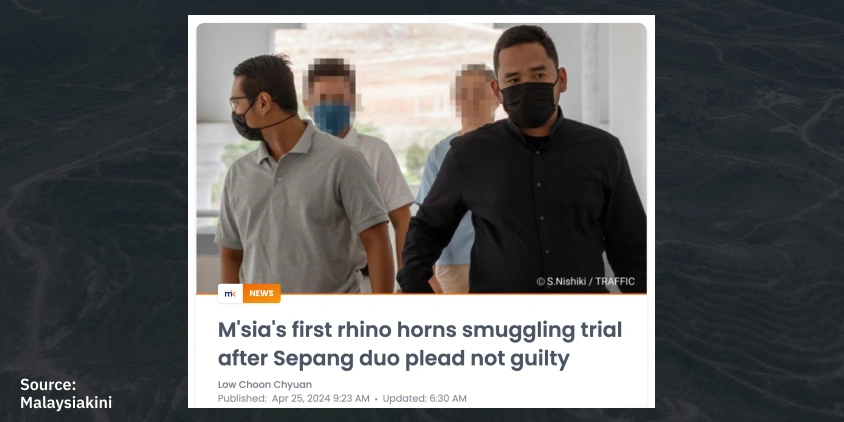
Despite uncertainties about his further professional development, Low is already working on another story related to human-elephant conflicts in that same region, a spin-off of his initial investigation.

Through this story, he hopes to highlight, discuss, and inform the public about the severity of human-elephant conflicts and the possibility of elephant extinction in the Peninsula due to competition for lowland forest habitats. He aims to shed light on the approaches taken by the government and conservationists, such as relocating elephants to other forests and promoting strategies for human-elephant coexistence, including creating corridors and designating feeding grounds.
Will Low’s work help improve the nature of Pahang for both local communities and animals to prosper? Will he turn to EOS Data Analytics again to see if satellite data analytics can help track elephants and their activity?
Follow us to find it out in our future stories of impact.
This Story of Impact is created following EOSDA’s vision to make space tech a global driver of sustainability on Earth. If you wish to share a story that relates to this idea and believe our solutions can help develop it, please contact us via pr@eosda.com.
About the author:
Maksym Sushchuk is at the forefront of realizing EOSDA's vision to make space tech a global driver of sustainability on Earth. He has over 15 years of experience in journalism and content creation for prominent Ukrainian startups, charitable funds and ESG businesses. As Head and Co-founder of PR Army Maxim brings attention to the human and social tolls of the aggression against Ukraine.
Recent articles

Transition Guide From Sentinel Hub EO Browser To EOSDA LandViewer
Need an EO Browser alternative that’s just as familiar but more flexible? EOSDA LandViewer offers free recent imagery, a vast satellite data archive, and advanced analytical tools.
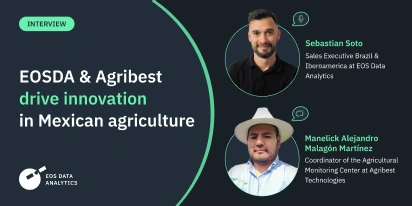
EOSDA & Agribest: Driving Agtech Growth In Mexico
In this insightful interview, Agribest shares how its collaboration with EOSDA is shaping Mexico’s agricultural future, with a focus on profitability, sustainability, and technology.

Top Ready-Made Agriculture Tools & Softwares for 2025
Agriculture softwares are silent partners in the field, working tirelessly behind the scenes to support farmers with insights and precision to cultivate sustainable agricultural ecosystems.